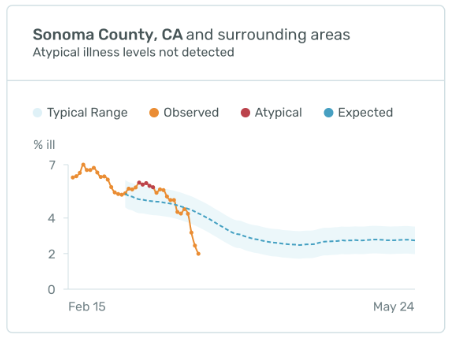
This is a weird one.
So, apparently there are these IoT thermometers out there.
And like most Internet of Things devices, their privacy is really bad, so the maker (Kinsa) is now sitting on a database of body temperature readings from something like a million customers.
So far, so bad.
But Kinsa is doing something really interesting right now.
They’ve used this database to create a map of the country that they’ll let you choose to have color-coded by the county-level stats for either:
- the number of observed high temperature readings
- how many more high temperature readings there are above what would be expected
- the trend (up or down) in the number of observed high temperature readings over the previous 7 days
This is interesting, and potentially very useful, because it can show you how abnormal levels of disease are distributed around the country and how that distribution is changing.
And wouldn’t you know it? We just happen to be having a problem right now with a novel disease that causes fevers, so it will show up in this data.
Huh.
That’s actually pretty cool.
It’s a massive privacy violation, of course, but this application of the data could be really useful.
It’s a shame it’s in the control of a private company who also knows lots more than just body temperature about each person though.
We should do something about that.
We could, for example, have a State-supported data warehouse with its systems properly siloed to prevent backtracking any record to the person it represents and mandate that devices like this be able to report to that warehouse if the user approves it (and mandate that if the company collects data like this that the company report it).
This kind of warehouse would, of course, need to be properly isolated from the normal functions of government to keep it from being abused. I discussed that issue a few days ago in Disrupt The State: Monolithic Governments Need To Go Away.
If I thought it was trustworthy, I might even get one of these thermometers just to do my part.
‘Cause this kind of thing could actually make the world a better place.
Which would make for quite a change from how IoT devices normally work.
Here’s an example.
If you read the post What’s The Problem: Math From The Back Of An Envelope, you’ll know that my local county appears to be around 3 weeks away from surpassing its extermely-optimistic-best-case scenario for how many COVID-19 cases it can handle if the infection rate doesn’t change.
You’ll also know that, since the virus has a 1-2 week incubation period, it’ll take 1-2 weeks for all the social-distancing and such to show up in the case numbers.
So it’s kind of a nail biter around here.
Kinsa’s map shows this for us right now:

Aside from annoyingly not marking the horizontal axis, which is just wrong, this is actually really hopeful and I’m pleased to see it.
Things are getting bad, and they might get much much worse, but there’s reason to hope that we can manage this.
So, if you live somewhere that hasn’t yet: shut it all down.
And start reorganizing your lives and work to keep it shut down. It appears to be working.
(Other posts on this topic are here.)


Since I wrote this one, the 7-day trend has gone from -12% to -15%. So, an additional day of stay-at-home improved the trend by 3 points.
That’s _really_ good news.
This is useful information outside the context of COVID-19, too: more working from home, more attention to hygene and fewer mass gatherings is having a serious effect on the normal flu season too.
Since the annual flu kills tens of thousands of citizens every year, we now have pretty good evidence that changing our behavior would help with that too.
One confounder in this data that will mess up the value of the trendline, though, is that anyone who does end up hospitalized (like around 20% of the COVID-19 patients) will stop using their home thermometer and will drop out of the high-temperature numbers.
This wouldn’t be the case in a scenario where this data was being collected by an independent State-supported data warehouse, since it’d be reasonable for hospitals to participate in collecting for that.